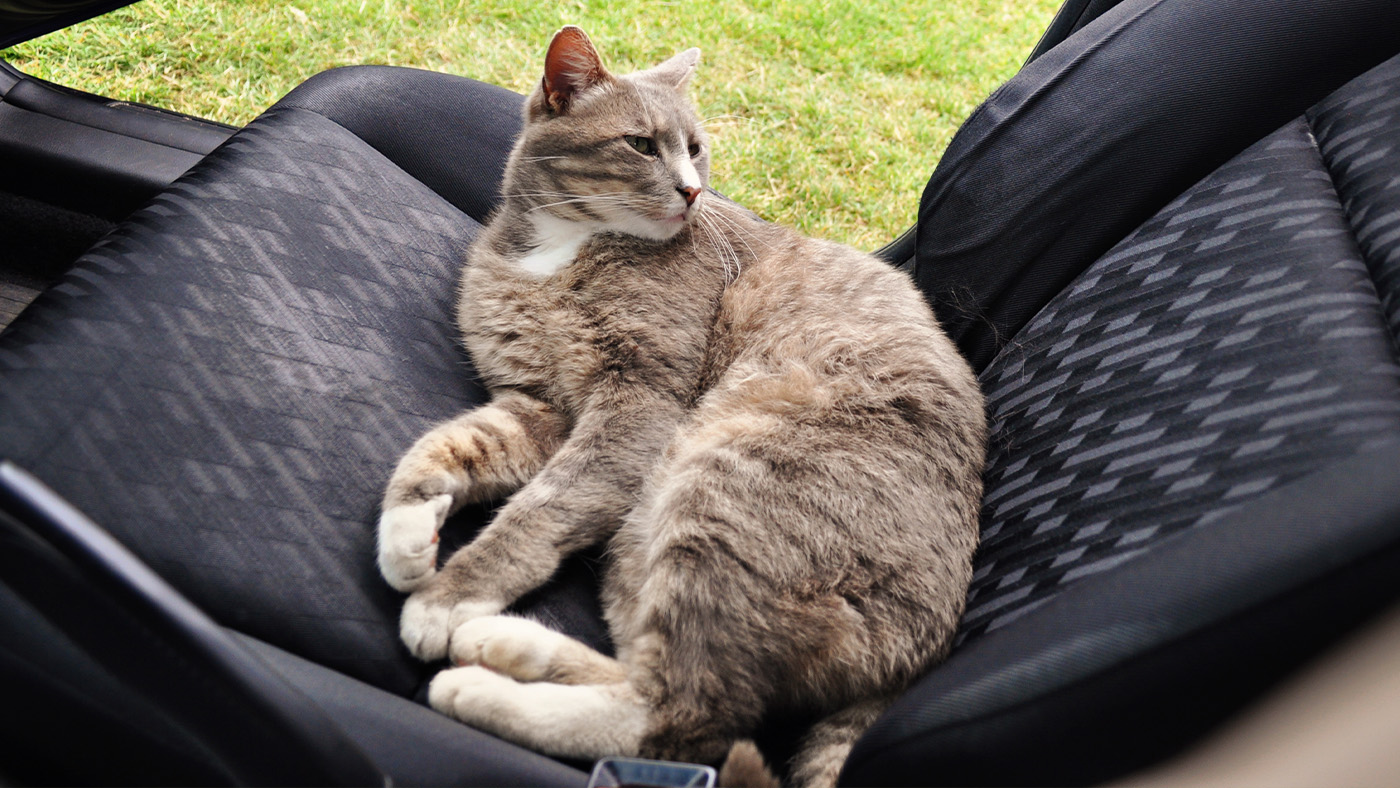What can hamsters eat? Advice from a vet on good hamster diets
Looking for answers to the question, ‘What can hamsters eat’? We asked a vet for some advice
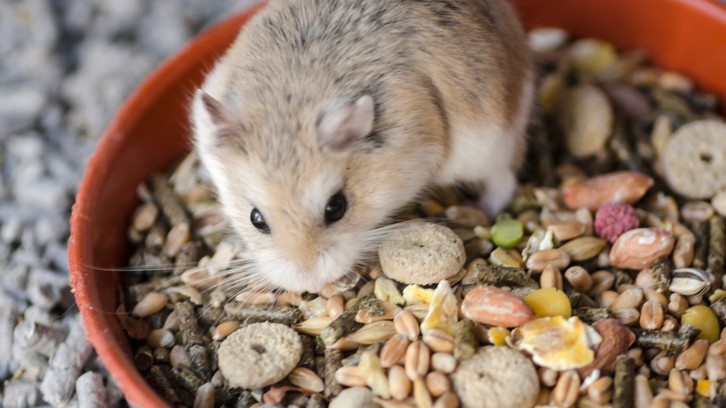
You’re not the only one asking, ‘What can hamsters eat?’ After all, there’s plenty of information about dog and cat food, but where do you go to find out what hamsters can eat? Is the food at the pet store enough, or do they need more? And what about treats?
Our knowledge of hamster nutrition and husbandry has come on a lot in the last few years, and these adorable creatures are finally getting recognition as great pets for adults and children alike. We’re going to look in detail at what hamsters can eat, as well as some things that should never be fed to your hamster.
- Best hamster toys: Amazing accessories for a happy hamster
- Best hamster cages: Find the perfect home for your hamster
What do hamsters eat?
Many owners are unaware that hamsters are actually omnivorous. This means they can have quite a varied diet that’s both plant and animal-based.
Although they’re often mistaken for herbivores (the wild hamster’s diet does primarily consist of seeds and grasses), they need a lot of protein for their size. For wild hamsters, this protein need is filled by eating insects and small animals such as frogs – and even lizards!
- How long can a hamster go without food?
- 5 reasons why your hamster is scared of you
- How to play with a hamster: Are you engaging properly?
What is the best food for hamsters?
Several commercial hamster diets exist in pet shops and it can be confusing which one to use.
Vets and nutritionists tend to agree that feeding your hamster a pelleted diet rather than a muesli-style diet is preferable. If you’ve been feeding your hamster a muesli mix, then you may have noticed that they eat the same bits first, every day. You may also have noticed that the same bits generally get left behind day after day, too.
This causes a problem – although the food is technically balanced throughout the bag, your hamster can pick out their favourite bits and leave the rest resulting in an unbalanced diet. And like children presented with a mixed bowl of sweets and vegetables, they’re unfortunately likely to pick out the high-calorie and less nutritious things. Therefore, hamsters fed on muesli-type foods are more prone to bad teeth, obesity, and diarrhoea.
This is why the answer to this is to buy pelleted feed for hamsters. It has all the same ingredients as many of the muesli diets, but they have all been blended and formed into equal pellets.
Your hamster can no longer accidentally unbalance his diet by picking out the bits he likes the taste of, as each pellet is identical to the next. If your hamster is currently on muesli, you should transition them slowly onto their new diet over a fortnight to avoid gut upset. Very gradually mix in some of the new food with their old diet, increasing the proportions of new to old over time.
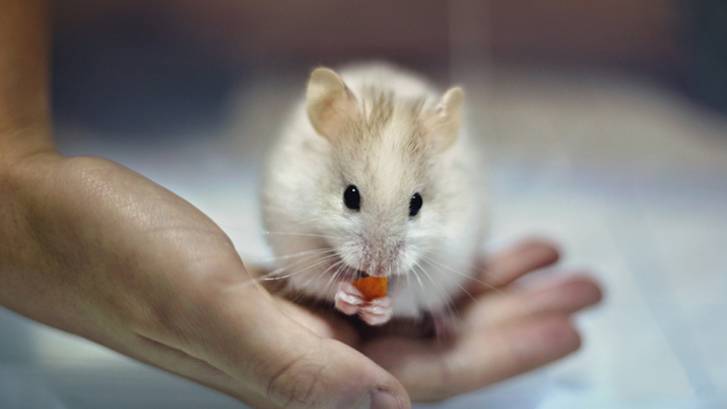
How much should I feed my hamster?
Hamsters usually only need 8-12 grams of pelleted food a day. Treats should make up no more than 5% of their daily diet, so to avoid your hamster becoming obese you should limit treats to half a gram or less (which is about the same as two raisins). As this is such a small amount you might find it a bit easier to give them a gram every other day instead.
Any time you try a new treat for your hamster, make sure you start by offering him a tiny amount at a time so that his guts are allowed to get used to it. Giving too much of a new food could cause diarrhoea. Getting to the point where you can give your hamster a different treat or fresh food each day will help keep him interested and provide him with a range of nutrients.
Just remember that you need to be thorough with your cage cleaning when you’re feeding fresh foods. Hamsters will often hoard food, and many fresh foods can go bad quickly, so they will be more likely to make your hamster ill.
8 foods you can feed your hamster
You’re probably thinking that a pelleted diet seems very boring compared to a muesli one. After all, those squashed peas and corn look so much more interesting and colourful than the pellets. So what can you give your hamster as a treat or snack?
1. Cruciferous vegetables
Cruciferous vegetables belonging to the brassica family that includes cabbage, cauliflower, kale, Brussel sprouts, and broccoli. They’re high in vitamins, minerals, and fibre, and low in calories. As with all vegetables you can give to hamsters, it’s best to start with a very tiny amount to avoid diarrhoea.
2. Carrots and sweet potatoes
Carrots and sweet potatoes are okay for hamsters to eat, but you should be aware that they’re quite high in sugar. On the plus side, they’re hard and may help to wear down their teeth and contain lots of fibre. Don’t feed them to your hamster too often, and only give a tiny amount – a cubic centimetre is plenty!
Just make sure to remove the skins from the sweet potato before you feed it, as this is the area most likely to carry mould and bacteria
3. Seeds
Your hamster will love seeds. Pumpkin and sunflower seeds are two particular favourites. You can feed them either with or without the husk, as long as the seeds you offer are not salted and contain no additives. They’re high in good fats, but restrict them to three a day to avoid obesity as they are very high in calories.
4. Mealworms and crickets
Mealworms and crickets are small insects that you can buy dried in pet shops and garden centres for feeding to birds. They are high in protein and make a healthy snack for hamsters, especially youngsters or pregnant hamsters, who have higher protein requirements. You should avoid giving your hamster mealworms if they’re elderly though, as too much protein can put a strain on the kidneys.
5. Peas and lentils
Peas and lentils are high in protein, so make a healthy addition to your hamster’s diet, especially if they’re growing, pregnant, or lactating. They’re also small, which helps with portioning. One or two peas is plenty for a daily portion.
6. Fruits
Most fruits are safe for hamsters, but they particularly enjoy strawberries, blueberries, bananas, and apples. These are all high in vitamins, especially vitamin C. However, fruits are also high in sugar, which can cause diabetes and obesity, so they shouldn’t be given daily. As usual, give a tiny amount – a cubic centimetre (or one blueberry) is plenty, and make sure you remove the seeds of apples before giving them to your hamster due to the levels of cyanide they contain.
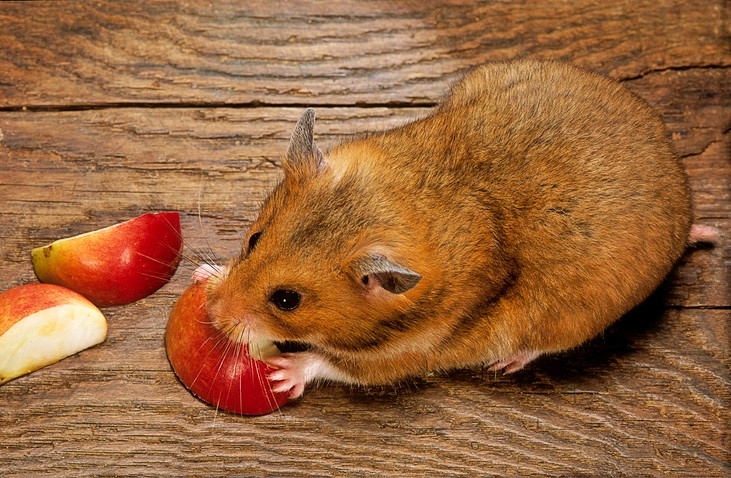
7. Nuts
You can feed your hamster most types of nuts, but almonds should be avoided due to their cyanide content. However, whilst nuts contain vitamins and minerals, they also contain lots of fat, and can quickly cause obesity and diarrhoea. A small number of chopped nut can be fed to your hamster, but don’t do this every day.
8. Chicken and eggs
As omnivores, hamsters can be fed small amounts of cooked chicken and hard-boiled eggs. Both are high in protein and contain amino acids not found in vegetables. However, you should take into account that both of these foods will rot very quickly at room temperature, and your hamster might have a secret food store. If you choose to feed chicken, check your hamster’s food stash later that day, and remove any uneaten bits of chicken or egg.
What can hamsters chew on?
Hamsters have teeth that are continually growing throughout their lives. They need to keep them worn to an appropriate length by chewing. Hard food will help, but they will also benefit from other items in their cage to gnaw on.
Anything you give your hamster must be safe and non-toxic because they may accidentally swallow some of what they chew. Cardboard tubes from toilet rolls, wood (either a small branch from a fruit tree, that hasn’t been treated with pesticide, like apple or pear, or pieces of untreated wood from the pet shop), fibre-rich veggies and chew toys are all good options.
You can even give them dog chews, as long as they don't contain garlic. But remember that if you're offering food or treats as a chew, you'll need to reduce their calorie intake from their main food, or else face an increasingly heavyweight hammy!
Rotating chews and toys every so often will give your hamster some essential mental stimulation and may help prevent other unwanted behaviours, such as chewing on the bars of their cage.
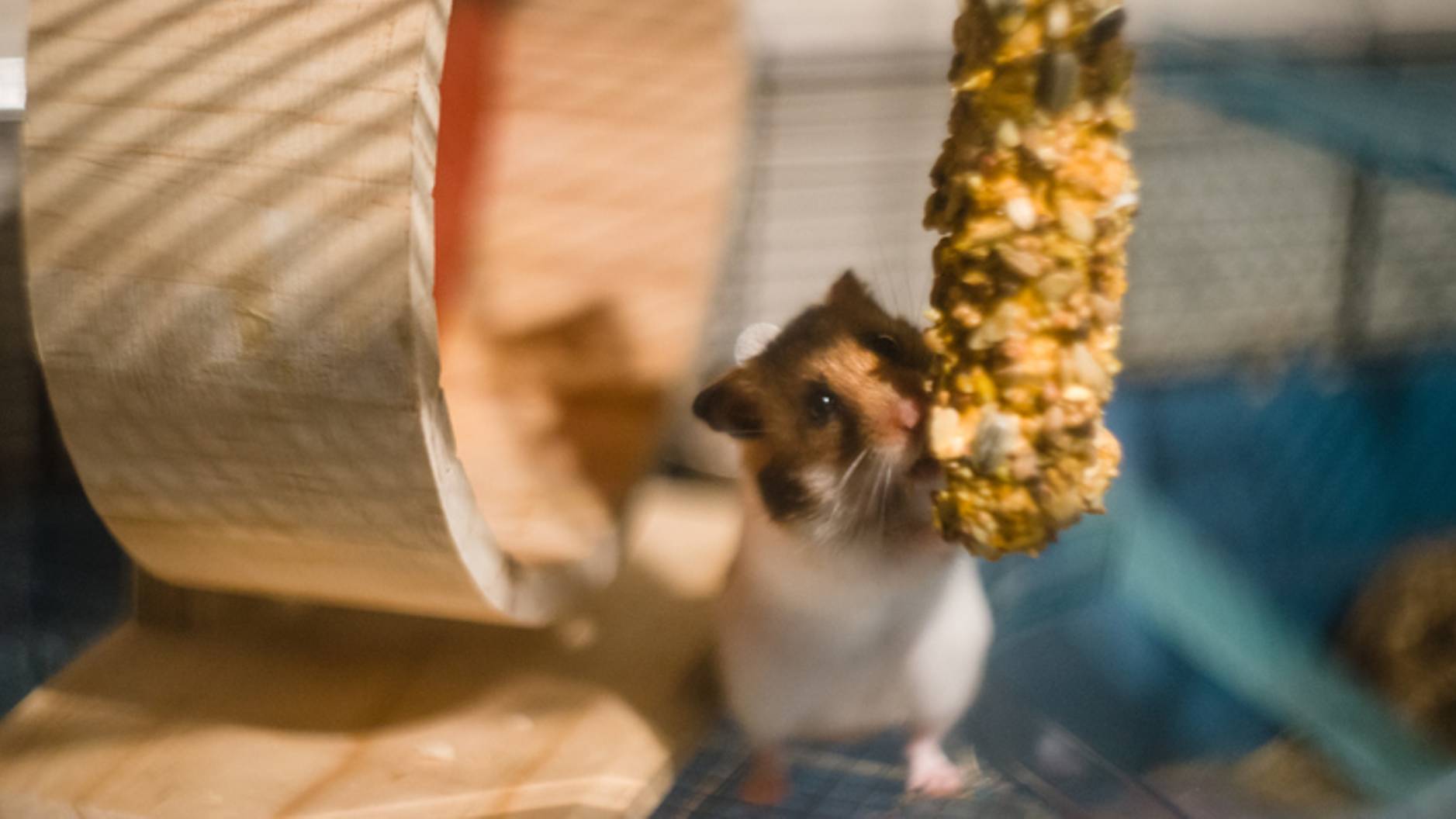
What not to feed your hamster
It’s important to mention that there are a few foods you should never feed your hamster.
Rhubarb is thought to be poisonous to rodents like hamsters, as it contains a toxin that can raise their heart rate. Eggplant (aubergine) is also on the toxic list for hamsters.
As well as being too sugary and processed, chocolate should be avoided due to its theobromine content. Just like in larger pets, onions and garlic can cause anaemia, and should not be fed to hamsters.
Don’t feed your hamster almonds; they contain cyanide. Raw beans should also be avoided, as they can contain toxins. Citrus fruits are too acidic for hamsters, and eating them may result in diarrhoea. It’s unclear whether tomatoes are toxic to hamsters, so they’re best avoided.
Whilst not directly poisonous, you should also avoid processed foods and junk foods, which are often of low nutritional value. Yoghurt drops, once a very popular pet shop treat for small mammals, should be avoided, as they’re very fattening and don’t contain useful nutrients. Similarly, human junk food should not be shared with your pet. This includes fried foods, cookies, cereal bars, crisps and processed meats.
Avoid anything too sharp (such as whole oats and straw), which can puncture your hamster’s cheek pouches. You should also avoid sticky foods, as these can get stuck to the inside of their cheek pouches. So, giving your hamster a sticky toffee is not recommended - it could result in a trip to the vets!
What can I feed my hamster if I run out of food?
As with many small mammals, gut upset from sudden diet changes can quickly cause diarrhoea. And hamsters, being so small, can go downhill quickly if this happens. If you run out of hamster food, you’ll need to determine how long it’ll be until you can get more.
If it’s just overnight, your hamster can have his usual vegetable treats and skip his pellets for one night – it’s likely to do him more harm to give him something new. Don’t forget that, unless you’ve just cleaned out the cage, your hamster likely has a hidden food store to raid if he’s ever hungry!
If you’re unlucky enough to run out of hamster food on a bank holiday weekend, you might need to come up with an alternative. The best emergency hamster food option is to give a mix of the safe foods listed above, trying to ensure that your pet has a protein source, a fat source, and a fibre source.
A small piece of sweet potato or carrot, 3-5 seeds or half a teaspoon of chopped nuts, and a tablespoon of mealworms or half a teaspoon of hard-boiled egg will provide most of what your hamster needs for a couple of days. It shouldn’t be used for longer than this though, as it’s not complete and balanced and will be lacking in vitamins and minerals.

What can hamsters drink?
Whilst it might seem a bit boring, water is the safest and healthiest option for hamsters. Although you might experiment with their diet and treats, don’t be tempted to do the same with their drinks.
Water contains everything your hamster needs, alongside their usual good quality hamster diet. Aside from water being so good for them, hamsters have sensitive tummies, so any change to their usual fluids could cause them to become unwell.
This means that even though offering them milk to drink might be okay in theory, it’s quite likely to cause them diarrhoea, which could lead to more serious symptoms. It’s also really tricky to offer milk without it spoiling due to the temperature in the cage.
Once the milk has 'gone off,' it poses a serious health risk to your pet. So, sticking to fresh water is the sensible option. Water should be offered in a bottle or bowl, replenished when empty, and replaced daily so that it is always fresh.
Conclusion
Hamsters can eat a variety of fruit and vegetables, but their main diet should be a complete pelleted ‘kibble’ for optimum nutrition. Just make sure you’re giving no more than half a gram of extra fruit, seeds, insects, or vegetables to avoid overfeeding as hamsters are very prone to obesity.
PetsRadar Newsletter
Get the best advice, tips and top tech for your beloved Pets
After graduating as a vet from the University of Nottingham, Dr Joanna Woodnutt went on to practice companion animal medicine in the Midlands. Since then, she has also written for countless online and print publications and is a regular contributor for Edition Dog Magazine.

